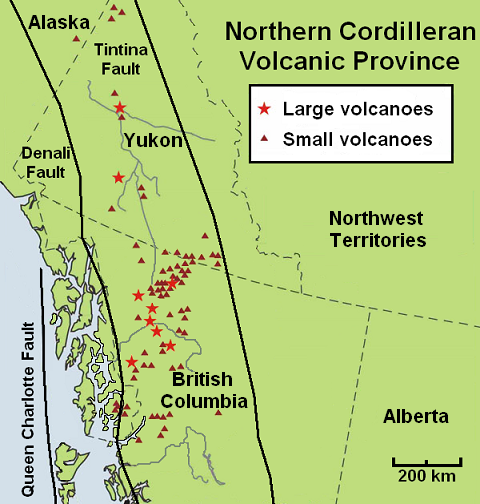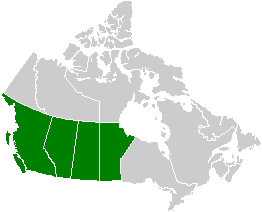|
Source Hill
Source Hill is a cinder cone in northwestern British Columbia, Canada. It is polygenetic in nature, having erupted more than once throughout its eruptive history.Catalogue of Canadian volcanoes: Source Hill It is one of the volcanoes in the central portion of the and last erupted during the period. See also * |
Cinder Cone
A cinder cone or scoria cone is a steep, volcanic cone, conical landform of loose pyroclastic rock, pyroclastic fragments, such as volcanic ash, clinkers, or scoria that has been built around a volcanic vent. The pyroclastic fragments are formed by explosive eruptions or lava fountains from a single, typically cylindrical, vent. As the gas-charged lava is blown violently into the air, it breaks into small fragments that solidify and fall as either cinders, clinkers, or scoria around the vent to form a cone that is often symmetrical, with slopes between 30° and 40° and a nearly circular base. Most cinder cones have a bowl-shaped volcanic crater, crater at the summit. Mechanics of eruption Cinder cones range in size from tens to hundreds of meters tall. They are composed of loose pyroclastic material (Scoria, cinder or scoria), which distinguishes them from ''spatter cones'', which are composed of agglomerated volcanic bombs. The pyroclastic material making up a cinder cone ... [...More Info...] [...Related Items...] OR: [Wikipedia] [Google] [Baidu] |
British Columbia
British Columbia is the westernmost Provinces and territories of Canada, province of Canada. Situated in the Pacific Northwest between the Pacific Ocean and the Rocky Mountains, the province has a diverse geography, with rugged landscapes that include rocky coastlines, sandy beaches, forests, lakes, mountains, inland deserts and grassy plains. British Columbia borders the province of Alberta to the east; the territories of Yukon and Northwest Territories to the north; the U.S. states of Washington (state), Washington, Idaho and Montana to the south, and Alaska to the northwest. With an estimated population of over 5.7million as of 2025, it is Canada's Population of Canada by province and territory, third-most populous province. The capital of British Columbia is Victoria, British Columbia, Victoria, while the province's largest city is Vancouver. Vancouver and its suburbs together make up List of census metropolitan areas and agglomerations in Canada, the third-largest metropolit ... [...More Info...] [...Related Items...] OR: [Wikipedia] [Google] [Baidu] |
Canada
Canada is a country in North America. Its Provinces and territories of Canada, ten provinces and three territories extend from the Atlantic Ocean to the Pacific Ocean and northward into the Arctic Ocean, making it the world's List of countries and dependencies by area, second-largest country by total area, with the List of countries by length of coastline, world's longest coastline. Its Canada–United States border, border with the United States is the world's longest international land border. The country is characterized by a wide range of both Temperature in Canada, meteorologic and Geography of Canada, geological regions. With Population of Canada, a population of over 41million people, it has widely varying population densities, with the majority residing in List of the largest population centres in Canada, urban areas and large areas of the country being sparsely populated. Canada's capital is Ottawa and List of census metropolitan areas and agglomerations in Canada, ... [...More Info...] [...Related Items...] OR: [Wikipedia] [Google] [Baidu] |
Mount Edziza Volcanic Complex
The Mount Edziza volcanic complex ( ; abbreviated MEVC) is a group of volcanoes and associated lava flows in northwestern British Columbia, Canada. Located on the Tahltan Highland, it is southeast of Telegraph Creek and southwest of Dease Lake. The complex encompasses a broad, steep-sided lava plateau that extends over . Its highest summit is in elevation, making the MEVC the highest of four large complexes in an extensive north–south trending volcanic region. It is obscured by an ice cap characterized by several Glacier morphology#Outlet glaciers, outlet glaciers that stretch out to lower altitudes. The MEVC consists of several types of volcanoes, including stratovolcanoes, shield volcanoes, cinder cones and lava domes. These volcanoes have formed over the last 7.5 million years during five cycles of magmatic activity which spanned four geologic epochs. Volcanic eruptions during these magmatic cycles produced a wide variety of volcanic rocks that comprise 13 geol ... [...More Info...] [...Related Items...] OR: [Wikipedia] [Google] [Baidu] |
Pleistocene
The Pleistocene ( ; referred to colloquially as the ''ice age, Ice Age'') is the geological epoch (geology), epoch that lasted from to 11,700 years ago, spanning the Earth's most recent period of repeated glaciations. Before a change was finally confirmed in 2009 by the International Union of Geological Sciences, the cutoff of the Pleistocene and the preceding Pliocene was regarded as being 1.806 million years Before Present (BP). Publications from earlier years may use either definition of the period. The end of the Pleistocene corresponds with the end of the last glacial period and also with the end of the Paleolithic age used in archaeology. The name is a combination of Ancient Greek () 'most' and (; Latinized as ) 'new'. The aridification and cooling trends of the preceding Neogene were continued in the Pleistocene. The climate was strongly variable depending on the glacial cycle, oscillating between cold Glacial period, glacial periods and warmer Interglacial, int ... [...More Info...] [...Related Items...] OR: [Wikipedia] [Google] [Baidu] |
List Of Volcanoes In Canada
List of volcanoes in Canada is an incomplete list of volcanoes found in Geography of Canada, mainland Canada, in the Islands of Canada, Canadian islands and in Canadian waters. All but two Provinces of Canada, provinces, Prince Edward Island and Manitoba, have at least one volcano. Alberta British Columbia New Brunswick Newfoundland and Labrador Northwest Territories Nova Scotia Nunavut Ontario Quebec Saskatchewan Yukon See also * Outline of Canada * Bibliography of Canada * Index of Canada-related articles * Volcanism of Canada ** Volcanism of Northern Canada ** Volcanism of Western Canada ** Volcanism of Eastern Canada ** List of Northern Cordilleran volcanoes * List of mountains in Canada * List of Cascade volcanoes External links Catalogue of Canadian Volcanoes {{Canadian volcanism Volcanoes of Canada, Lists of volcanoes, Canada Lists of mountains of Canada, Volcanoes Lists of landforms of Canada, Volcanoes Canada geology-related li ... [...More Info...] [...Related Items...] OR: [Wikipedia] [Google] [Baidu] |
List Of Northern Cordilleran Volcanoes
The geography of northwestern British Columbia and Yukon, Canada is dominated by volcanoes of the Northern Cordilleran Volcanic Province formed due to continental rifting of the North American Plate. It is the most active volcanic region in Canada. Some of the volcanoes are notable for their eruptions, for instance, Tseax Cone for its catastrophic eruption estimated to have occurred in the 18th century which was responsible for the death of at least 2,000 Nisga'a people from poisonous volcanic gases, the Mount Edziza volcanic complex for at least 20 eruptions throughout the past 10,000 years, and The Volcano (British Columbia), The Volcano (also known as Lava Fork volcano) for the most recent eruption in Canada during 1904. The majority of volcanoes in the Northern Cordilleran Volcanic Province lie in Canada while a very small portion of the volcanic province lies in the U.S. state of Alaska. Volcanoes of the Northern Cordilleran Volcanic Province are a part of the Paci ... [...More Info...] [...Related Items...] OR: [Wikipedia] [Google] [Baidu] |
Volcanology Of Canada
Volcanism, Volcanic activity is a major part of the geology of Canada and is characterized by many types of volcanic landform, including lava flows, volcanic plateaus, lava domes, cinder cones, stratovolcanoes, shield volcanoes, submarine volcanoes, calderas, diatremes, and maars, along with less common volcanic forms such as tuyas and subglacial mounds. Though Canada's volcanic history dates back to the Precambrian eon, at least 3.11 billion years ago, when its part of the North American continent began to form, volcanism continues to occur in Western Canada, Western and Northern Canada in modern times, where it forms part of an encircling chain of volcanoes and frequent earthquakes around the Pacific Ocean called the Pacific Ring of Fire. Because volcanoes in Western and Northern Canada are in relatively remote and sparsely populated areas and their activity is less frequent than with other volcanoes around the Pacific Ocean, Canada is commonly thought to occupy a gap in t ... [...More Info...] [...Related Items...] OR: [Wikipedia] [Google] [Baidu] |
Volcanology Of Western Canada
Volcanism of Western Canada has produced lava flows, lava plateaus, lava domes, cinder cones, stratovolcanoes, shield volcanoes, greenstone belts, submarine volcanoes, calderas, diatremes and maars, along with examples of more less common volcanic forms such as tuyas and subglacial mound A subglacial mound is a type of subglacial volcano formed when lava erupts beneath a thick glacier or ice sheet. The magma forming these volcanoes was not hot enough to melt a vertical pipe right through the overlying glacial ice, instead forming ...s. Volcanic belts * * * * * * * * * External links Erica A. Massey: A Comparative Study of Glaciovolcanic Palagonitization of Tholeitic and Alkaline Sideromelane in Helgafell, Icland, and Wells Gray-Clearwater Volcanic Filed, BC, Canada. B.Sc., The University of British Columbia, 2014 Volcanic fields * * * See also * * * * ReferencesVolcanoes of Canada . . . . {{Manitoba-stub ... [...More Info...] [...Related Items...] OR: [Wikipedia] [Google] [Baidu] |
Cinder Cones Of British Columbia
Cinder or Cinders may refer to: In general *Ember, also called cinder * Ash, also called cinder *Scoria, or cinder, a type of volcanic rock In computing *Cinder (programming library), a C++ programming library for visualization *Cinder, OpenStack's block storage component *Cyber Insider Threat, CINDER, a digital threat method Arts and entertainment * ''Cinders'' (1913 film), a 1913 silent film * ''Cinders'' (1920 film), a 1920 film starring Hoot Gibson * ''Cinders'' (1926 film), a 1926 British film starring Betty Balfour *Cinder (musician) (born 1961), stage name of Scottish musician Cindy Sharp * ''Cinder'' (album), by the Dirty Three * ''Cinder'' (novel), a novel by Marissa Meyer * ''Cinders'' (visual novel), a 2012 visual novel adaptation of Cinderella by MoaCube Fictional characters * Linh Cinder, the character from the novel and ''The Lunar Chronicles'' series * Cinder Fall, a major antagonist in the animated web series RWBY * Cinder, a character in the ''Killer Instinct'' ... [...More Info...] [...Related Items...] OR: [Wikipedia] [Google] [Baidu] |
Volcanoes Of The Mount Edziza Volcanic Complex
A volcano is commonly defined as a vent or fissure in the crust of a planetary-mass object, such as Earth, that allows hot lava, volcanic ash, and gases to escape from a magma chamber below the surface. On Earth, volcanoes are most often found where tectonic plates are diverging or converging, and because most of Earth's plate boundaries are underwater, most volcanoes are found underwater. For example, a mid-ocean ridge, such as the Mid-Atlantic Ridge, has volcanoes caused by divergent tectonic plates whereas the Pacific Ring of Fire has volcanoes caused by convergent tectonic plates. Volcanoes resulting from divergent tectonic activity are usually non-explosive whereas those resulting from convergent tectonic activity cause violent eruptions."Mid-ocean ridge tectonics, volcanism and geomorphology." Geology 26, no. 455 (2001): 458. https://macdonald.faculty.geol.ucsb.edu/papers/Macdonald%20Mid-Ocean%20Ridge%20Tectonics.pdf Volcanoes can also form where there is stretching an ... [...More Info...] [...Related Items...] OR: [Wikipedia] [Google] [Baidu] |
Polygenetic Cinder Cones
Polygenesis can refer to: * Polygenesis (linguistics), a theory of language origin * Polygenism, an obsolete theory of human origin * Gene duplication, a form of genetic disorder resulting in the overexpression of a particular gene * Polygenetic landforms, landforms formed the accumulative action of various processes See also * Polygene A polygene is a member of a group of non- epistatic genes that interact additively to influence a phenotypic trait, thus contributing to multiple-gene inheritance (polygenic inheritance, multigenic inheritance, quantitative inheritance), a type o ..., member of a group of interacting genes * Monogenism (other) {{disambig ... [...More Info...] [...Related Items...] OR: [Wikipedia] [Google] [Baidu] |





